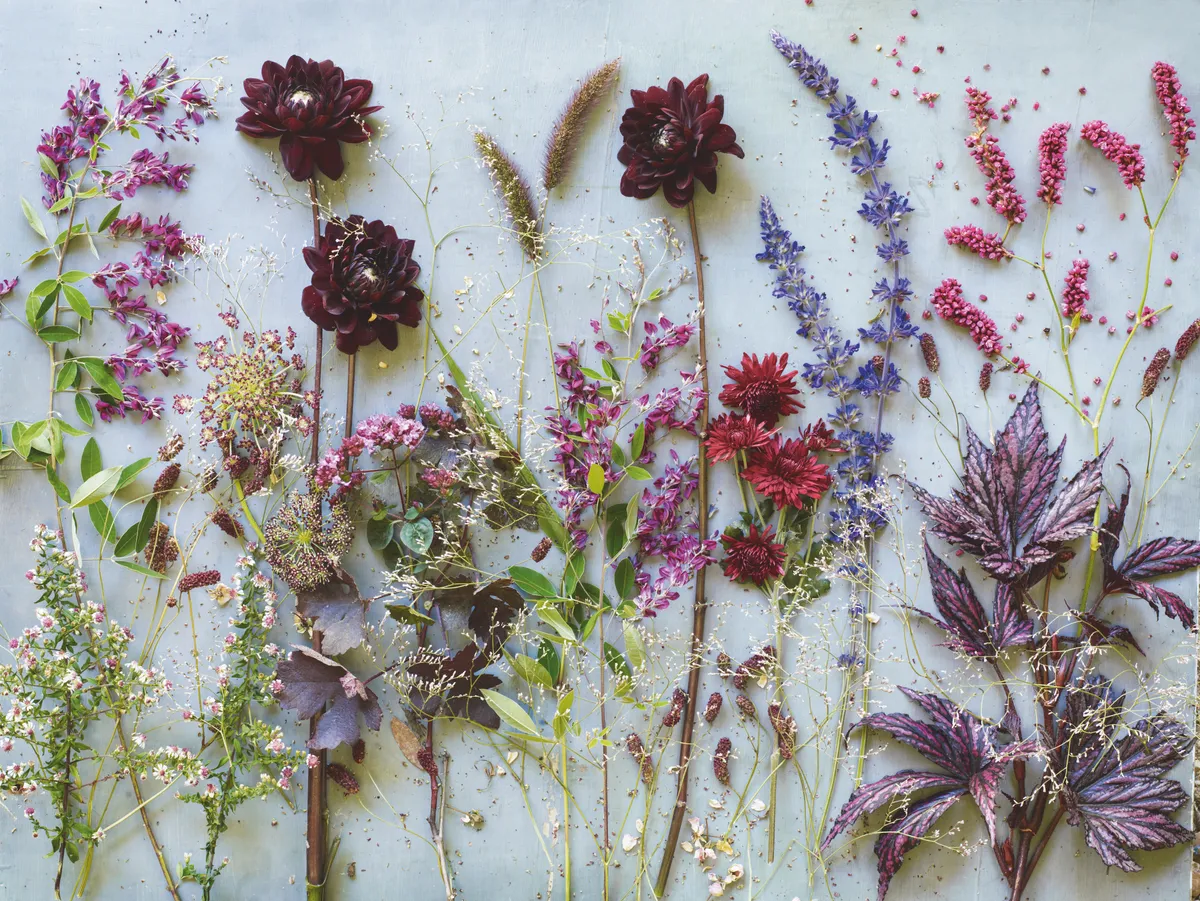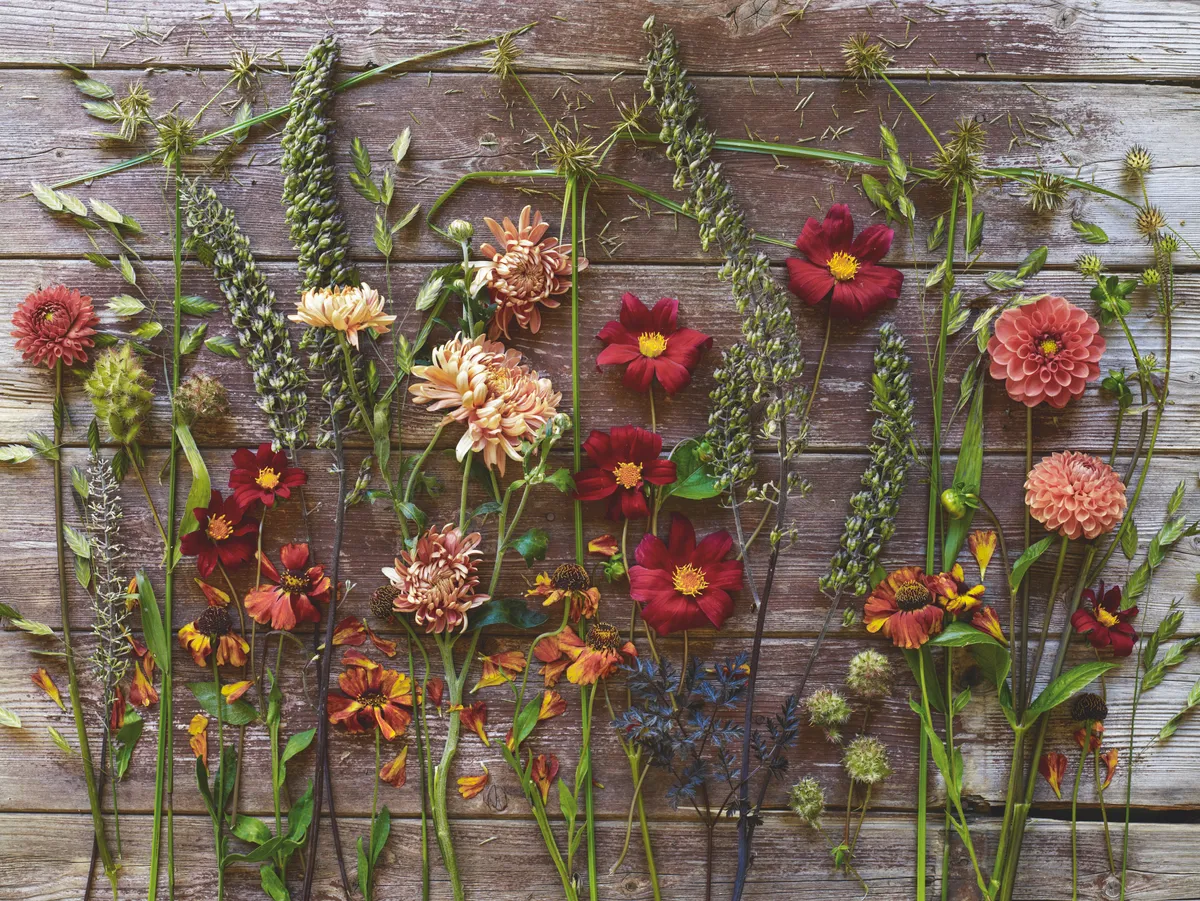There is so much satisfaction to be had in growing your own. Whether it's starting a vegetable garden, a small-scale combination for containers or growing a flower border to supply your home with seasonal cut-flower displays.
If you grow your own flowers you have control over your materials, when they are harvested and displayed, and can always work with plants in season.
Florist and cut-flower grower, James Horner
These two combinations for late-summer cut-flower displays have been put together by James Horner, a flower gardener, occasional planting designer and floral stylist. James went through rigorous horticultural training at Great Dixter and now he makes floral installations for fashion shows and wild bunches for celebrations.
Combinations for cut-flower displays
Port wine

- Symphyotrichum lateriflorum var. horizontalis Horizontal calico aster, which Christopher Lloyd cleverly used to replace a failing lavender hedge at Great Dixter. Delicate pink-eyed daisies by the thousands. 40cm. Award of Garden Merit (AGM). RHS H7 (hardiness rating).
- Lespedeza thunbergii Given a warm situation this late-flowering shrub will be covered with purple pendulous, branches popular with late bees. Useful for its trailing habit. 80cm. AGM. RHS H5, USDA 4a-8b.
- Sanguisorba tenuifolia ‘Henk Gerritsen’ A robust burnet with tens of flower stems,
thick with slightly pendulous, antennae-like, burgundy burrs. Its slightly unpleasant smell dissipates when dried. 1.6m. - Daucus carota ‘Dara’ This pink seed strain of the wild carrot can be grown as a biennial on lighter soils. The jewel-like flowers are backed with lacy foliage. Very useful for cutting, so make lots of sowings. 60cm.
- Dahlia ‘Karma Choc’ The best dark chocolate dahlia after ‘Sam Hopkins’. Its strong stems are ideal for bouquet work. 50cm. AGM. RHS H3, USDA 7a-10b.
- Vitis vinifera ‘Purpurea’ If given a hot wall this vine produces port wine-coloured foliage with an aged, mahogany tone. Let its festoons trail beyond the vase. 3m. AGM. RHS H5, USDA 6a-9b.
- Origanum laevigatum ‘Herrenhausen’ Its aromatic foliage is a magnet for bees. The short stems and purple flowers are great in wilder bouquets. 30cm. AGM. RHS H7.
- Setaria macrostachya ‘Will Scarlet’ A short annual grass that self seeds promiscuously in a dry garden. Its moody caramel-coloured seedheads are perfect in an autumn bouquet. 40cm.
- Limonium platyphyllum Perennial statice offering a perfect lacy veil for the border and the bouquet. Dries beautifully for a winter decoration. 40cm. RHS H7, USDA 3a-9b.
- Chrysanthemum ‘Ruby Mound’ This hardy chrysanthemum lasts well in the border and the house. Refresh water to prolong vase life. 50cm. AGM. RHS H3, USDA 5a-9b.
- Salvia ‘Indigo Spires’ A favourite tender sage for summer displays. Tall, snaking, blue spires add height to arrangements. Propagate by cuttings in summer. 60cm.
- Begonia ‘Benitochiba’ Grow as a houseplant and move outside to enjoy the summer. The foliage has iridescent and metallic markings that add mystery and drama to exotic arrangements. 30cm. AGM. RHS H1B.
- Persicaria orientalis Also wonderfully known as kiss-me-over-the-garden-gate, this is the perfect annual flower for hanging installations, or dried bunches. 1.5m.
Rust

- Chasmanthium latifolium Evocative of late summer ripeness, this is a wild oat grass with diamond-shaped, flat florets on arching stems. These are stunning added to hand-tied bouquets. 50cm. RHS H7, USDA 3a-8b.
- Glycyrrhiza yunnanensis It’s the intricate seedheads of this airy perennial that warrant inclusion in the garden. They will persist all winter. 1.5m. RHS H5.
- Actaea simplex (Atropurpurea Group) ‘Brunette’ The sweetly scented, white-spired actaea with dark foliage, goes on to produce a spectacular seedhead that adds structural depth to an arrangement. 90cm. RHS H7, USDA 3a-8b.
- Dahlia coccinea ‘Mary Keen’ Bright, yet rich burgundy single, acquired by Great Dixter from gardener and designer Mary Keen. Easy and reliable in the garden; fleeting and informal in the vase. 70cm.
- Chrysanthemum ‘Salmon Allouise’ A favourite of James’s who, as a boy, grew cuttings of chrysanthemums with his uncle. The inward-curving petals make it an attractive addition to bouquets, and large blooms make excellent stand-alone feature flowers. 70cm.
- Cyperus vegetus A plant that self-sows nicely and makes gardening easy. The strong triangular stems are topped with an umbrella-like explosion of sword leaves and seeds. 40cm.
- Anthriscus sylvestris ‘Ravenswing’ A dark-leaved cow parsley with frothy, white flowers, evocative of English country lanes in spring. Adds lustre to bouquets. 60cm. RHS H6.
- Dipsacus pilosus The small teasel, with its surround of minute, fur-like hairs, is one of the best plants to catch the evening light. Adds texture and interest to a bouquet, but doesn’t out-shine the star attractions. Biennial. 1.5m.
- Helenium ‘Sahin’s Early Flowerer’ Without doubt one of the best heleniums to date, excellent for its repeat flowering. The second flush is particularly well suited to October tones. 60cm. AGM. RHS H7.
- Dahlia ‘Cornel Brons’ Along with its red sister, known simply as ‘Cornel’, this dahlia performs well, producing bloom after bloom. A tight, long-lasting cut flower with a colour range that goes from pumpkin to bronze to slightly salmon. 80cm.
Words by Francine Raymond
Photographs Andrew Montgomery